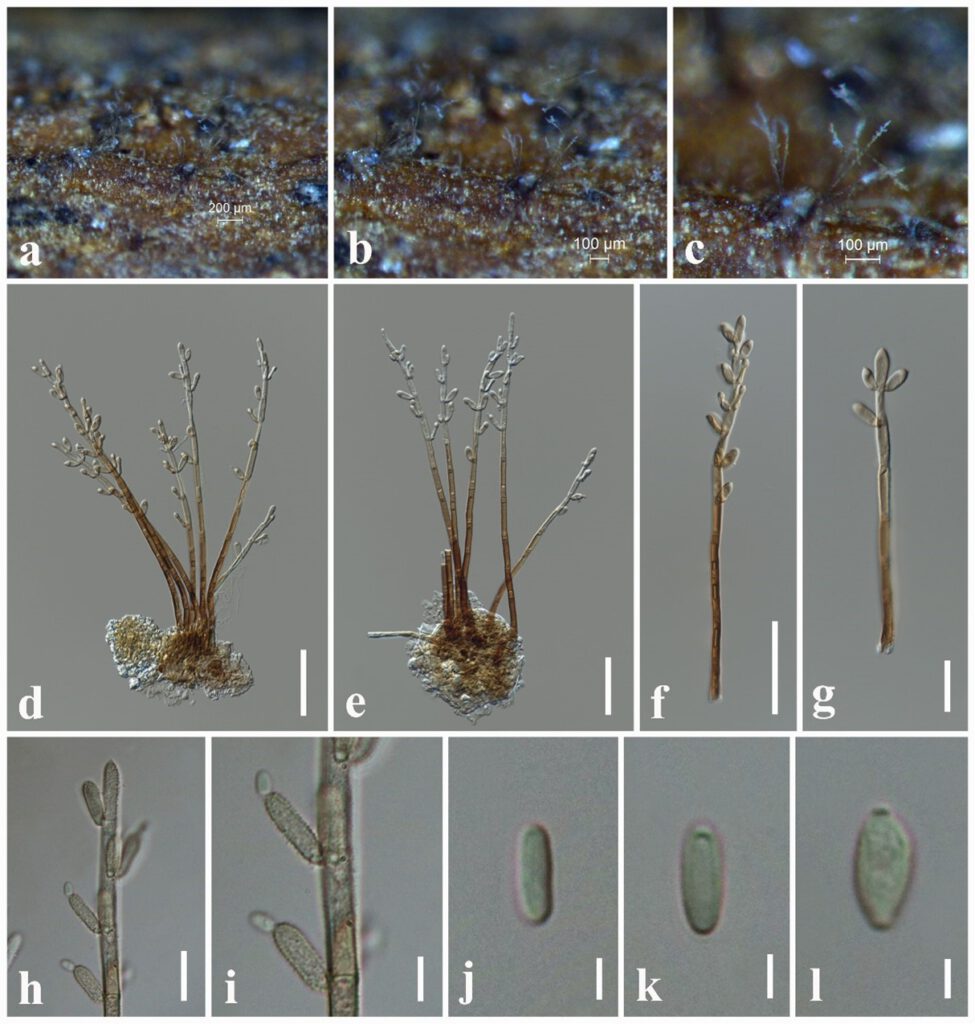Plectosphaerella canangae N.I. de Silva, Lumyong & K.D. Hyde, sp. nov.
MycoBank number: MB; Index Fungorum number: IF; Facesoffungi number: FoF 10721; Fig. 6.58
Etymology: Name reflects the host genus Cananga, from which the new species was isolated.
Holotype: MFLU 21-0243.
Saprobic on dead twigs attached to Cananga odorata. Sexual morph: Undetermined. Asexual morph: Hyphomycetous. Conidiophores 100–180 × 4–5 ( = 150 × 4.4 µm, n = 10), hyaline, pale brown, cylindrical, erect, unbranched, septate, thick-walled. Conidiogenous cells 6–14 × 2–6 ( = 10 × 3.5 µm, n = 10), phialides hyaline, pale brown, terminal, lateral, cylindrical, sub-cylindrical or ampulliform, thick- and smooth-walled. Aseptate conidia 3–7 × 1.5–3 ( = 5 × 2.2 µm, n = 25), formed in slimy heads at the apex of the phialides, hyaline, subglobose to ellipsoidal, aseptate, tapering to rounded apex and base, smooth, thin-walled.
Culture characteristics – Colonies on PDA reaching 30 mm diameter after 1 weeks at 25°C, colonies from above: circular, margin entire, flat, surface cottony with aerial mycelium, white; reverse: cream.
Material examined – THAILAND, Chiang Rai Province, dead twigs attached to host plant of Cananga odorata (Annonaceae), 2 January 2019, N. I. de Silva, CO5 (MFLU 21-0243, holotype), ex-type living culture, MFLUCC 21-0171, KUMCC 20-0061.
Notes – A new strain (MFLUCC 21-0171) forms an independent lineage distinct from a clade comprising Plectosphaerella populi and P. sichuanensis with 77% ML and 0.90 BYPP statistical support. The new strain and P. populi have hyaline smooth, aseptate conidia, however, the new strain has slightly larger conidia (5 × 2.2 µm) than P. populi (4 × 2 µm) (Crous et al. 2015). Plectosphaerella sichuanensis differs from the new strain in having slightly larger (5.2 × 3.3 µm) conidia than the new strain and also P. sichuanensis has 1–3 guttulate conidia (Yang et al. 2021). Plectosphaerella populi was isolated on branch of Populus nigra in Germany (Crous et al. 2015) and P. sichuanensis was isolated from Potamogeton pectinatus as an endophyte in China (Yang et al. 2021). We therefore, introduce the new strain as a novel species, P. canangae based on morphology and phylogeny.

Figure 6.58 Plectosphaerella canangae (MFLU 21-0243, holotype) a–c Appearance of colonies on substrate. d, e Conidiophores. f, g Conidiophore and phialides. h, i Phialides and conidia. j–l Conidia. Scale bars: b, c = 100 μm, d–f = 50 μm, g = 20 μm, h = 10 μm, i = 5 μm, j–l = 2 μm
